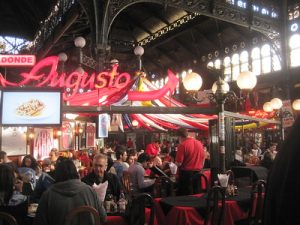17 Lesson 6D
1. Escuchar. Listen to and read the following dialogue among three elementary school students. Then decide if the statements are Cierto (C) o Falso (F).
Carlos: ¡Hola, Ana! ¡Hola, Lily! ¿Qué están haciendo?
Ana: Hola, Carlos. Estoy haciendo un dibujo para la clase de arte.
Lily: Y yo estoy escribiendo una carta para mi abuela. Es su cumpleaños mañana.
Carlos: ¡Qué bien! Tengo unas galletas para compartir con ustedes.
Ana: ¡Gracias, Carlos! Oye, ¿qué tienen que hacer para la tarea de matemáticas?
Lily: Tenemos que resolver diez problemas para mañana. Es un poco difícil.
Carlos: Sí, es verdad. Para mí, las matemáticas son difíciles, pero practico mucho para mejorar.
Ana: Yo también. ¿Qué hacen después de la escuela?
Lily: Voy para la casa de mi tía. Ella vive cerca de la escuela.
Carlos: Yo voy al parque para jugar el fútbol. ¿Quieren venir?
Ana: Me encantaría, pero tengo que estudiar para un examen.
Lily: Yo también tengo que estudiar, pero vamos para el parque el viernes, ¿verdad?
Ana: ¡Sí!
- Ana está trabajando en una tarea para su clase de arte. C / F
- Carlos tiene chocolates para compartir con sus amigas. C / F
- La tarea para la clase de matemáticas es para la próxima semana. C / F
- Ana, Lily, y Carlos deciden ir al parque para jugar el fútbol el viernes. C / F
2. Escoger. Read the following sentences about the new vocabulary.
Paso 1. Select the verb that logically completes each sentence.
- La cometa es para __________________________ (caminar / volar).
- La bicicleta es para __________________________ (montar / crecer).
- El peluche es para __________________________ (abrazar / cortar).
- La cera es para __________________________ (entregar / dibujar).
- El recreo es para __________________________ (jugar / soplar).
- Las tijeras son para __________________________ (pedir / cortar).
Paso 2. Talk with a partner to decide if these sentences are using para as recipiente o propósito.
Paso 3. Following the model of these sentences, work with your partner to write you own sentence using a different vocabulary word from this lesson.
3. Celebrar. Hoy tu escuela va a celebrar el Día de Agradecimiento al Maestro (Teacher Appreciation Day). Think about what activities that you can do to show your appreciation.
Paso 1. Work with your partner to decide which five activities you will do to show your appreciation. You can use the activities listed in the chart or come up with your own.
| Voy a llevar un pastel a clase | Tengo que decirle “muchas gracias” |
| Voy a comprar flores para mi profesor | Tengo que escribirle una tarjeta de saludo |
| Voy a hacer mi tarea a tiempo | Tengo que portarme bien |
| Voy a cantar una canción | Tengo que llevarle una manzana |
| Voy a llegar temprano a la clase | Tengo que hacer una fiesta |
Modelo:
Para mi maestro, yo tengo que portarme bien (behave well)..
Paso 2. With your partner, determine if the above statements correspond to recipiente or opinión.
4. Hablar. Read the following short paragraph about paid maternity leave (el permiso de maternidad) in Spain.
En España, el permiso de maternidad es un derecho (right) importante para las madres trabajadoras. La duración de la licencia es de 16 semanas, y es posible ampliarla en casos de parto (birth) múltiple o discapacidad del niño. Durante este tiempo, la madre recibe un subsidio del 100% de su salario base. Esta medida (measure) es crucial para el bienestar (well-being) de la madre y del bebé y para permitirles pasar tiempo juntos después del nacimiento.

Paso 1. Find a partner and share your reactions to the information in the paragraph using Para mí... Follow the model.
Modelo: Para mí, el permiso de maternidad es un derecho necesario. Creo que (I believe that) todos los trabajos deben permitir el permiso de maternidad de por lo menos doce semanas.
Paso 2. Take turns asking your partner about their thoughts on some of the topics in the bank. Follow the model.
Modelo:
| Estudiante A | Estudiante B |
| ¿Qué piensas de vivir con una compañera de cuarto? | Para mí, es muy divertido vivir con una compañera de cuarto porque me gusta estudiar y salir con ella. |
| La música de Taylor Swift | Los niños y las redes sociales | Estudiar en el extranjero |
| Vivir con una compañera de cuarto | Las mujeres en los deportes | Los restaurantes cerca de la universidad |
Paso 3. Talk with a partner to decide if these sentences are using para as opinión o propósito.
5. Discutir. Students have to deal with a lot of deadlines. Study the following chart and think about when everything is due.
Paso 1. Take turns asking and answering when an event will take place.
Modelo:
| Estudiante A | Estudiante B |
| ¿Para cuándo es el proyecto? | El proyecto es para el lunes.. |
| El proyecto | Lectura de filosofía | La tarea corta de biología |
| La composición de la clase de inglés | La actividad de matemáticas | El informe de química |
Paso 2. Talk with a partner to decide if these sentences are using para as propósito o fecha límite.
6. Escribir. Think about a fun summer camp experience.
Paso 1. Complete these short prompts.
- Para mí, un campamento muy divertido es el campamento de…
- Los campistas asisten (attend) a este campamento para…(be sure to use an infinitive verb here)
- Mis actividades favoritas en este campamento son…
Paso 2. Using the information from the prompts above and any other relevant ideas, write a paragraph of 4-6 sentences about a fun camp.
7. Escuchar. Listen to the following short descriptions that a high school teacher gives about his students María, Héctor, and Juan.
María:
Héctor:
Juan:
Paso 1. Using the adjectives from the bank, fill out the chart with the three adjectives you hear to describe each student.
| Feliz | Introvertida | Extrovertida | Creativa | Callada |
| Traviesa | Ruidosa | Estudiosa | Tímida | Responsable |
|
|
 Héctor
|
Juan |
|
|
||
|
|
||
|
|
Paso 2. Using the adjectives from the word bank, pick at least 2 and describe them to your partner in Spanish. You can use useful expressions like, “es el contrario de”, “es un sinónimo de”, or “un ejemplo es…”
Modelo:
| Estudiante A | Estudiante B |
| Es el contrario de introvertida. | ¿Es extrovertida? |
| Sí. ¡Muy bien! |
8. Identificar. Based on the pictures, use the preposition por to talk about which places María passes through, along, or beside on her way to work at an elementary school.

Modelo: A: ¿Por dónde pasa María? B: María pasa por una iglesia. |
 |

|
 |
9. Interactuar. In this activity, you will collect information from at least 5 classmates about the time they spend on different activities each week. After gathering the data, you will create a chart to show the average time spent on each activity.
Paso 1. Collecting Information. Ask at least 5 students the following questions. Make sure to write down their answers in Spanish.
Modelo: ¿Cuántas horas juegas un deporte a la semana? Juego un deporte por tres horas.
- ¿Cuántas horas estudias español a la semana?
- ¿Cuántas horas haces ejercicio a la semana?
- ¿Cuántas horas tocas un instrumento a la semana?
- ¿Cuántas horas juegas videojuegos a la semana?
Paso 2. Write a short paragraph about a classmate based on the information you collected in Paso 1.
Modelo:
Andrew estudia español por tres horas a la semana. Él toca el piano por cinco horas todos los domingos. Nunca hace la tarea. Andrew corre por una hora todos los días.
10. Investigar. In this activity, you and your classmates are going to lead a summer camp called “Hantesa” in Iowa. With your partner, plan activities for a two-day event for youths. Follow the steps below to create your activity plan and item list.
Paso 1. Plan the activities for Day 1 and Day 2. Use the expressions from the word bank (or you can add new ones) to create the activities. Complete the itinerary for both days.
| Caminar por los senderos | Preparar la hamaca |
| Jugar a la pelota | Limpiar la cabaña |
| Tomar una siesta | Nadar en el río |
| Jugar a las cartas | Escalar el cerro (hill) |
| Preparar la cena | Preparar el almuerzo |
| Día 1 | Día 2 |
Por la mañana:
|
Por la mañana:
|
Al mediodía:
|
Al mediodía:
|
Por la tarde:
|
Por la tarde:
|
Paso 2. From the list below, choose 3-4 items that you and the campers will need to bring to the camp. Then add 2 more of your own ideas to the list.
Lista de materiales
- Linterna (flashlight)
- Repelente de insecto
- Saco de dormir
- Juguetes: pelotas, cartas, etc.
- Hamaca
- Música
- Loción de protección solar (sunscreen)
11. Leer. A group of college students are getting ready to study abroad in Santiago, Chile.
Paso 1. Read the itinerary and indicate the places you like. You can use the Internet to learn more about these locations.
- Lunes: Visitas a la Plaza de Armas y la Catedral Metropolitana
- Martes: Subida al Cerro San Cristóbal y Zoológico Nacional
- Miércoles: Visitas al Museo Chileno de Arte Precolombino y Museo Bellas Artes
- Jueves: Visitas al Palacio de la Moneda y el Museo de la Memoria y los Derechos Humanos
- Viernes: Almuerzo en el Mercado Central
Me gusta…
Paso 2. Based on the itinerary, complete the sentences using the correct form of por o para.
- Pedro va a caminar (por/para) la Plaza de Armas el lunes.
- Juan va a subir al Cerro San Cristóbal (por/para) sacar fotos de las montañas.
- Manuel pasa (por/para) el Mercado Central porque quiere comprar pescado fresco.
- Elena sale (por/para) el Museo de Bellas Artes al medio día.
- Marta y Clara van a tomar una siesta (por/para) una hora antes de visitar el Museo de la Memoria.
Paso 3. Look at the sentences you completed in Paso 2 and explain the meaning of the sentence according to the preposition you selected. Think about if they indicate propósito, destino, duración de tiempo, ruta (through, along, beside), o medio de comunicación.
Modelo:
Pedro va a caminar por la Plaza de Armas el lunes. Explanation: Here, “por” indicates the route or passage through a place, in this case, the Plaza de Armas.
12. Conversar. Work with a partner. You each have a different schedule that shows some of María and Juan’s daily plans for the next four days. Take turns asking about the other person’s activities, and fill out the blank spaces with their answer. Follow the model. Don’t forget to conjugate the infinitive verbs in the él/ella/elle/Ud. form of the present tense.
Modelo:
| Estudiante A
(tiene el horario de María) |
Estudiante B
(tiene el horario de Juan) |
| ¿Qué hace Juan el miércoles por la mañana? | Juan va a la escuela por autobús. |
| (Writes Juan’s plans in the blank space on their schedule): Juan va a la escuela por autobús. |

 María
María

